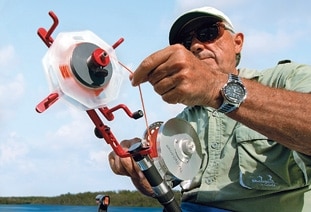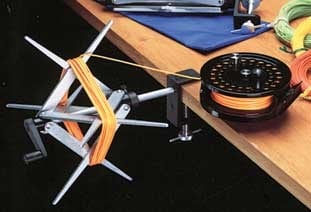
Even when it comes to something as seemingly simple as loading a new fly line onto a reel, gadgets can be a godsend in the world of fly-fishing. I learned this lesson early on.
Summer was fast approaching, and I was in need of a new intermediate 9-weight. Big snook would soon be amassing along the beaches where I lived, and I knew that I’d need to replace my old, worn-out line to up my chances for some nice fish.
I purchased a new line at the local fly shop, and as I was locking in the connection between the backing and the tail end of the running line, I could almost feel a big linesider already! I slowly began reeling up the line. At first, coils were unraveling beautifully off the ground. Then suddenly – from nowhere – a monstrous orange bird’s nest emerged. What a mess!
It took a while to work those tangles out, but eventually I got that slick new line onto the reel. Things could’ve been so much easier, though. In retrospect, a line winder would’ve helped.
Simplify Your Rigging
T.L. Lauerman, sales manager at Wapsi, parent company of Anglers Image, chuckles relaying his thoughts on the subject: “Without a line winder, you’re typically laying the line on the ground, and a lot of the time, it can become a minidisaster,” he says. “The first time someone tries one of these, they usually wonder how they’ve lived so long without one.”
No doubt, a line winder can help simplify your rigging. These products may look like something out of Einstein’s closet, but most are innovative contraptions developed by smart anglers who sought easier, faster ways to rig fly lines and backings. The Anglers Image line winder, for instance, is built with collapsible arms that, when locked into place and engaged by a crank, spin like a wheel, collecting fly lines in neat coils.
Line winders are great for taking line both on or off a reel. They’re also handy for cleaning lines or removing lines for storage. While most saltwater anglers own extra spools (each holding a different line type) for their reels, Lauerman correctly notes that “spare spools are expensive!” He continues: “They’re probably the most efficient, but a lot of guys will just use two or three lines on the same reel. That’s when line winders are really nice. They allow him to quickly collect the various lines, clean them and then store them with twist-ties almost like they were new.”
On-The-Water Readiness

Of course, the ability to rig those lines in the field is of huge importance to saltwater fly-fishermen, especially when traveling far from home. Unfortunately, fly lines are occasionally lost at sea. Connections fail, and backings are frequently cut on coral and rocks. When that happens, you must be ready, or there’s no more fishing for the day.
That’s what led Ted Juracsik, founder of Tibor Reel Corp., to build the LineMaster. A truly portable line-management system, the LineMaster employs a spring-loaded disk system that holds a spool firmly in place while you remove or load line and backing. Designed to be used by a single operator, the device applies steady tension that prevents line from tangling or binding.
Better yet, the LineMaster is available with a leg saddle with Velcro straps that simultaneously attach to the contraption and wrap around an angler’s leg. This provides a steady base from which to work and load a line, similar to an indoor fly-tying bench.
“That’s the big thing,” says Marianne Papa, marketing director at Tibor, and also Juracsik’s daughter. “It allows you to change lines in the field because of that leg saddle that dad came up with.”
Papa has fond memories of helping her dad load lines as a child and remembers that he always stressed keeping firm tension on the line. “These spring-loaded disks allow you to do this by yourself,” she says. “But the most unique feature is that leg saddle and clamping system. Changing lines is a common thing while on the water, and this allows you to do so in a simple, one-person operation.”
Evolution and Innovation
Jeff Pentecost, president of Glenn Struble Manufacturing, similarly takes pride that his company’s line winder is portable. “It comes with a bench mount,” Pentecost says, “but you don’t have to use it. The unit collapses on itself and fits inside a backpack.”
Struble has been building its line winder since about 1994, and with the product’s no-nonsense architecture, it’s no surprise that it has undergone only minor tweaks in design over the years. But as rods and reels continue to evolve, so must related accessories, and Struble plans to release a revised line winder in early 2010 that will have “expanded functionality and will accept a broader range of reel sizes,” says Pentecost.
In part, the rise of so many new, large saltwater reels capable of taking pelagic species led to this decision, and Pentecost says that the new line winder will accommodate these reels – as well as the tiniest of trout reels – with ease.
It’s equipment evolution at work. And that’s a good thing.









